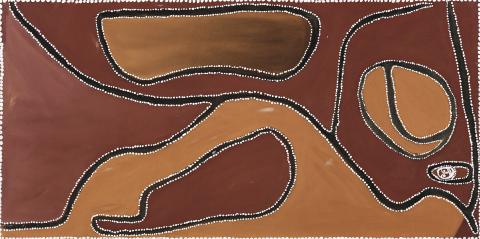RUBY PLAINS MASSACRE 1, 1985
ROVER THOMAS (JOOLAMA)
natural earth pigments and bush gum on canvas
90.0 x 180.0 cm
Commissioned in 1985 by Mary Macha, Perth
Holmes à Court Collection, Heytesbury, Western Australia (accession no. 1260)
Sotheby's, Sydney, 24 June 2002, lot 113
Private collection
Sotheby's, Sydney, 25 November 2007, lot 79
The Luczo Family Collection, USA
Ruby Plains Killing 2, 1990, in the collection of the National Gallery of Australia, Canberra, illus. in Thomas, R., et al., Roads Cross: The Paintings of Rover Thomas, National Gallery of Australia, Canberra, 1994, p. 45
Bedford Downs Massacre, 1987, illus. in Carrigan, B., Rover Thomas: I want to paint, Holmes à Court Gallery, Perth, 2003, cat. 11
Bedford Downs Massacre, 1985, illus. in Carrigan, B., Rover Thomas: I want to paint, Holmes à Court Gallery, Perth, 2003, cat. 12
Originally in the Holmes à Court Collection, this painting is one of the first produced by Rover Thomas that concerns the killings of Aboriginal people in the eastern Kimberley that occurred from late 19th century through to the 1920s. The killings usually happened in retaliation for what was perceived by the cattle station owners as the theft of cattle by local Aboriginal people living in a traditional manner. The introduction of cattle in the Kimberley polluted the freshwater wells and streams that fed large game such as kangaroo and emu that Aboriginal people relied on for protein; deprived of that source, they resorted to hunting another type of meat that had become available. Rover Thomas’ paintings of these conflicts at Bedford Downs, Texas Downs and Ruby Plains cattle stations constitute a form of history painting, based upon not first-hand experience but oral history. Several of these paintings are held in the Holmes à Court Collection and National Gallery of Australia, Canberra.
In Rover Thomas’ record of the Ruby Plains killing, he describes how the station owner and manager discover a group of men butchering a cow. They shoot two, maybe four men and decapitate them, placing the heads in hollow tree trunks. Over the following days, Aboriginal stockmen at Ruby Plains search for them and are led to the killing site by crows circling above. As a result, they abandon the cattle station which is forced to close. Significantly, while the majority of Thomas’ paintings are devoid of figurative imagery, those about the Ruby Plains killing contain an image of a skull inside a hollow tree trunk.
WALLY CARUANA
